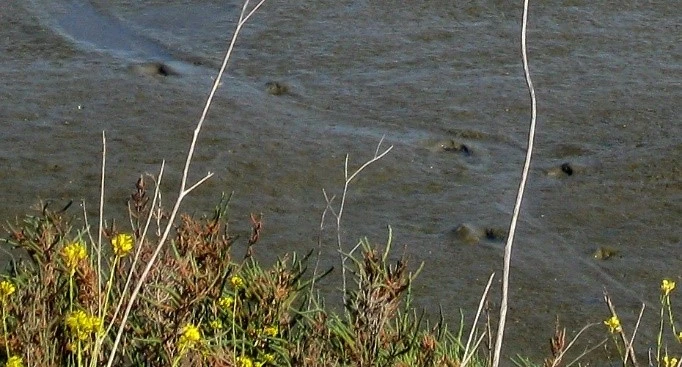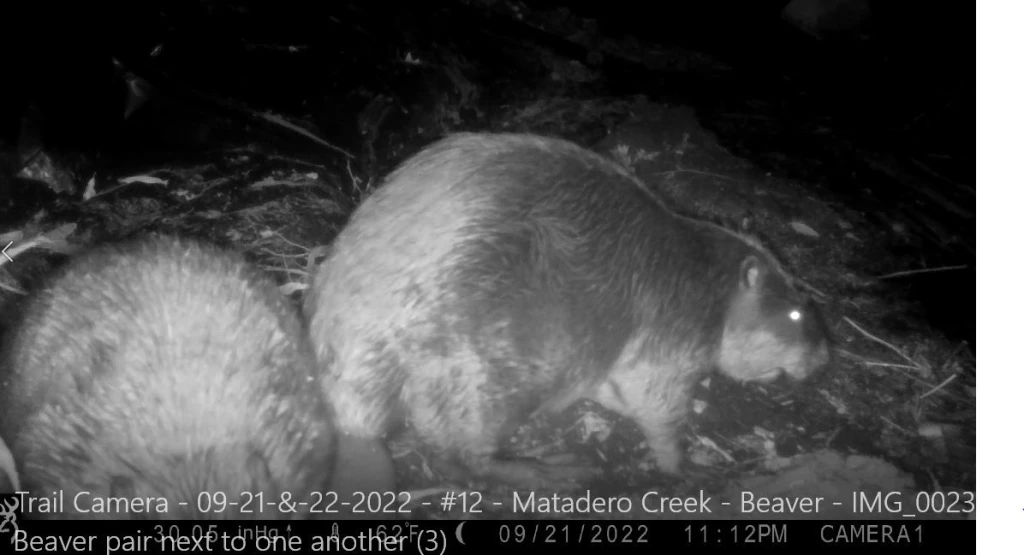Beavers In the Creek
by William C. Leikam
President, CEO & Co-founder, Urban Wildlife Research Project
"Let our work lift this planet from its present illness" - WCL

In a somewhat hushed tone of voice, as if wanting to pass on a secret that he didn’t want anyone else to overhear, he said, “Two days ago, down on the creek, I was in a kind of light meditation. When I opened my eyes and looked into the water, something large passed. Then yesterday, I went back down there – it’s a favorite spot of mine – but before I got there, sitting on the bank apparently grooming itself was what I can only say was a beaver. Thirty to forty pounds.”
“Are you sure? Can you show me right where you saw it?”
He showed me. Had it not been for a few other reports such as foot prints and a tail drag photographed in April 2008 by Richard Stovel in Charleston Slough, and again by another person in 2012, I may have dismissed his comments but with those to suggest that it might be possible, I set up a trail camera in mid-March 2022 and waited until as my data entry reflects: “Trail Camera – 03-29-&-30-2022 – Beaver camera #12 – IMG 0020 – Possible beaver grooming at frame’s edge.” Since the photo didn’t show the tail for instance, or any other definitive features, I just waited and in April I saw not only the tail but a full-frontal image of the beaver. As far as I could tell, the beaver only visited that one area once every two to three weeks, but return it did. The night of data entry “Trail Camera – 04-16-&-17-2022 – Beaver Camera #12 -– IMG 0031 – Beaver brings back more stuff from creek.” That night the beaver was very busy coming and going before the camera 10 times. In one video it brings a lot of leaves and decayed matter from the creek and deposits it on the bank. It looked as if beaver may have been in the process of cleaning the water channel.

For months of monitoring the beaver, the question that was always asked was, “Are there two?” My response prior to Trail Camera – 09-21-&-22-2022, was always “No, I’ve only seen one as far as I can tell.” However, on that date, right there in the video, two beavers made an appearance. I had to ask, “Are these two beavers making history on this creek?” According to Dr. Richard Lanman, of the Institute for Historical Ecology, “Matadero Creek is the Spanish name, meaning “the butchering place” and likely somewhere along its course the Mission Santa Clara padres had their cattle slaughtered. So, it is the historic name. Our 2013 publication … found an 1855 beaver skull in Saratoga Creek, the nearest physical evidence. But if there were beaver on Saratoga Creek then they would have been all over the South Bay not long before. Rather than “making history” one might say the Matadero Creek beaver(s) are re-colonizing or maybe “re-making history.”
Let our work lift this planet from its present illness. WCL – 9/10/2022
Gray Foxes General Health
These two foxes appear to be in good health. The previous indication that one of them may have worms has not proven to be the case.
Total Numbers of Gray Foxes in the Palo Alto Baylands Nature Preserve
As of this date, we have two adult gray foxes living in the Palo Alto Baylands Nature Preserve.
Section II
Update for the Urban Wildlife Research Project
Available Now: Bill’s book The Road to Fox Hollow has been released and can be found at Barnes & Noble Booksellers and directly from the publisher Di Angelo Publications.
Available Now: Learn more about Bill’s work with the foxes in The Foxes, My Professors, a video documentary produced at Stanford University by Syler P.R.
Dr. Marc Bekoff has an interview with Bill and that can be accessed at The Social and Emotional Lives of Urban Gray Foxes .
Bay Nature Magazine – “How to be a Fox” The article about Bill and his ethological approach to his study of the gray fox is online here. Many are calling this a major article in the wildlife press.
BE SURE TO check out our YouTube Channel for some incredible wildlife videos at and our Facebook page.
See Discipline Raccoon Style here.
Bill has an additional live event coming up at Los Altos High and Safari West in October. He will be live at Safari West https://www.safariwest.com/ in the Elephant Room, so if you’ve never been to Safari West, come on up for the day and hear Bill from 7:00 – 8:00 PM.
Undoubtedly the best Radio interview ever – KALW (PBS program Crosscurrents) – by Sofie Kodner during December 2020 – Broadcast 1/11/2021 5:00 PM. Check it out here.
You can access Bill’s PowerPoint presentation Corridors & Connections: Sustaining the Health of All Wildlife presented during the October 24th P-22 Urban Wildlife Festival here.
NEW – To find out more about us, search Urban Wildlife Research Project, UWRP, gray foxes, wildlife connection, linkages, corridors, and several documentaries including the video clips.
Gray Foxes General Health
These two foxes appear to be in good health.
Total Numbers of Gray Foxes in the Palo Alto Baylands Nature Preserve: As of this date, we have two adult gray foxes living in the Palo Alto Baylands Nature Preserve.
Section III
Gray Fox, Baylands Goals
Within the permit that allows the Urban Wildlife Research Project to conduct its study of the behavior of the gray fox at the Palo Alto Baylands Nature Preserve, the objectives covered area:
- Monitoring of urban gray fox Denning sites in Palo Alto Baylands.
This is being accomplished during the period when the gray foxes use a den site. It is one of the prime locations for gathering most of the behavioral data of the litter and for adults alike.
- Assessment of status and population trends of Baylands urban gray foxes
Since January 2019 a pair of resident gray foxes have claimed territory at the Palo Alto Baylands Nature Preserve.
- Identification of habitat features that promote the presence of urban gray foxes
After considering this and talking with people who know how to restore habitats, we need to assess what kinds of plants, including the Alkaline Salt Bush, would grow best along the edge of the saltwater channel and alongside the marsh. We need to grow a permanent habitat that contains the corridors and plant it as soon as possible. We’ll keep an eye on this as this is a critical link between the southern region of the Baylands and the northern region.
- Assessment of reproductive success and identification of factors that promote successful reproduction
Open up the pinch-point along Matadero Creek by developing thickets that link one area to another, instead of the present “islands”.
- Identification and assessment of possible dispersal travel routes.
Presently there can only be guesses as to dispersal travel routes. We intend to make this important question much more concrete when we attain our collaring/take/capture permit from the Department of Fish & Wildlife.



